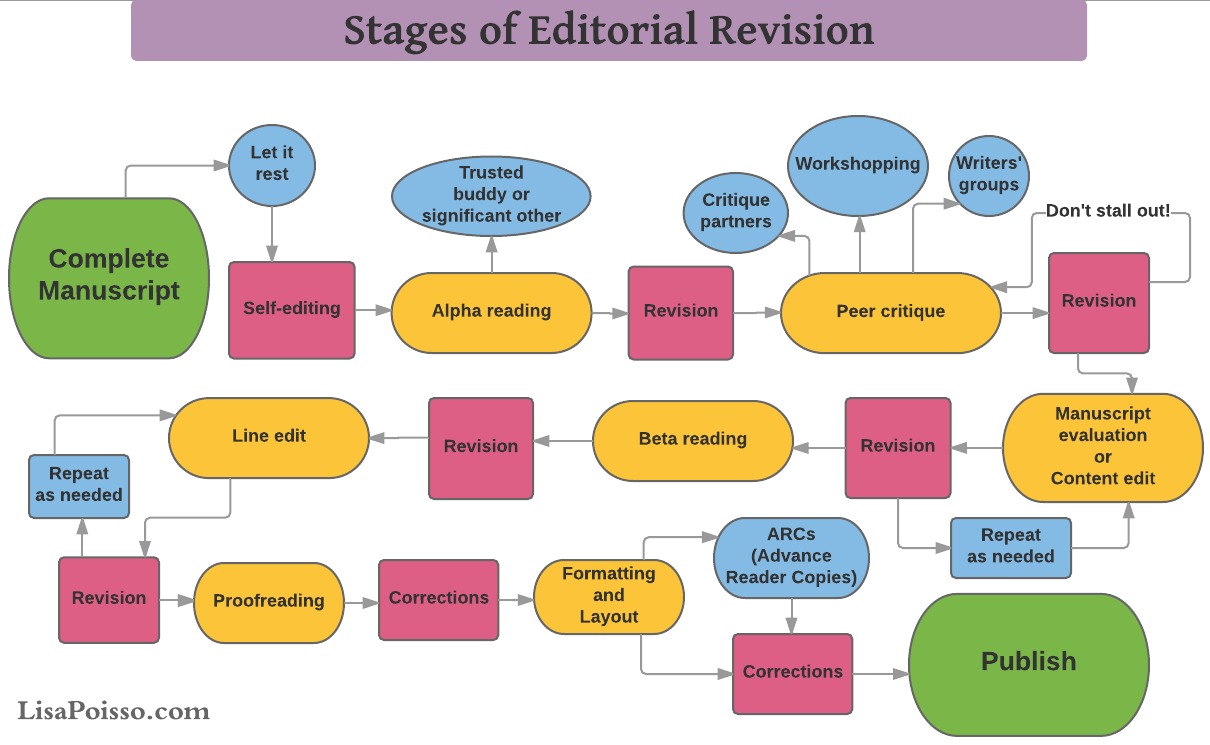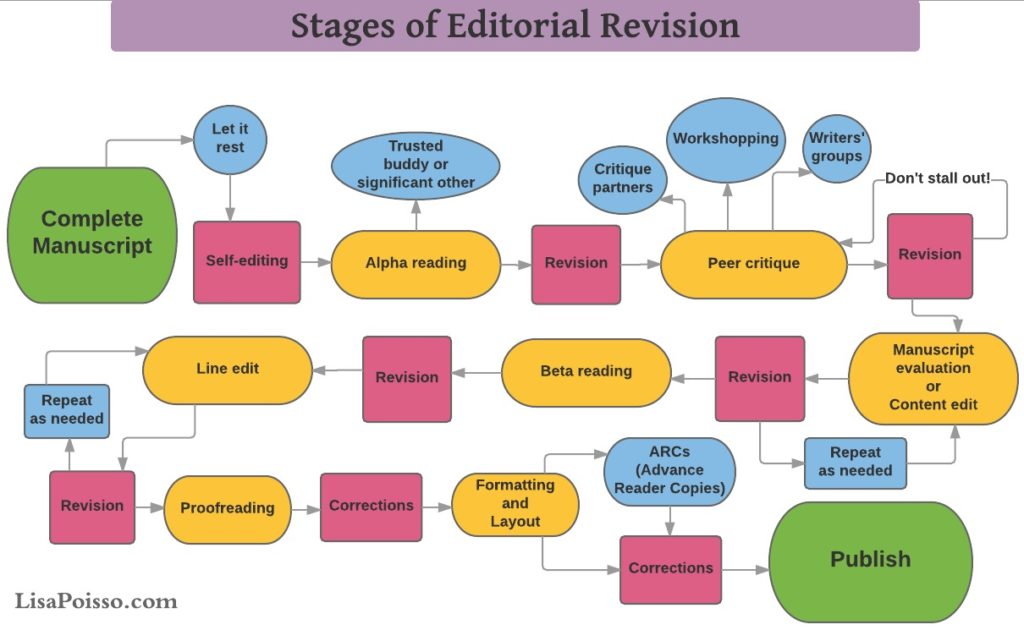Whoa, just look at that flowchart! That’s way too many steps!
Why, yes. Yes, it very likely is.
Few self-published authors can afford all of these editorial production steps. Few would want to even if they could. But the truth is that this does mirror the traditional editorial and revision process. If a publishing company that’s banking its profits on producing quality books goes through all of these steps, a self-publisher with a personal stake in their product should probably consider the benefits of replicating that process.
The super-duper secret behind this flowchart
But self-publishing is different in scale. A self-publisher doesn’t have the staff or budget to snake through this time- and money-consuming process.
Let me let you in on the secret behind this flowchart. This flowchart isn’t actually about the number or order of the individual steps. See all the little rosy-red boxes that pop up between each different step? The ones that say things like “Self-Editing” or “Revision” or “Corrections”?
Those little guys are the whole point.
Every single one of those rosy little friends represents an opportunity for you to roll up your sleeves and improve your manuscript. We get it: you’re one person with one set of eyes that probably glazed over long ago from reading and re-reading the same words in your manuscript. So don’t pass up a shot at pulling someone else in for a different perspective. Add more opportunities for feedback, more opportunities to check specific elements in your novel, and more opportunities for a fresh look.

Search out alternatives
Here’s another secret (oh look, two secrets in one article!): nobody is holding your feet to the fire and forcing you to pay a professional top dollar for every one of these steps. For every client I work with who wants the executive treatment, I have others who’ve chosen options designed to kick-start their own DIY follow-up.
What’s that? You don’t see those things listed on my website? That’s because they’re not things I recommend as baseline editing services. But once you’ve established a quality foundation, I’m all about helping you bring in your book to the highest standards possible within your own budget and parameters.
The editing and revision process
Let’s look briefly at each step of editing and revisions and what benefits each holds for your book. Remember that sandwiched in between each of these stages—see the pinkish boxes?—should be a healthy dose of author revision.
1. Complete manuscript The milestone you thought would be the biggest moment of your publishing journey (other than actual publication) is only the first step in the editorial process.
2. A fresh eye Before you can effectively revise your manuscript, you need time away from it. Aim for at least a few weeks, preferably longer. Your goal is to come back to your manuscript with an entirely fresh perspective.
3. Self-revision If you’ve heard that editing is the hardest part of writing a novel, you heard right. Don’t do yourself the disservice of skimming over your first draft to fix a few commas and then calling it done. The most successful authors I work with go through at least three to four drafts before they consider their manuscript ready for another person’s eyes. Start with the hard stuff back by revising at the story level.
4. Alpha reading Your alpha readers are the first outside eyes on your manuscript. Most authors use less than a handful of alpha readers. Whether your alpha readers are personal or professional contacts, you should trust them to have your best interests at heart and be gentle yet forthright with realistic feedback. All you’re looking for at this stage is reassurance that the story hangs together overall. Avoid readers who want to focus on details like spelling, punctuation, and grammar at this stage; you’re looking for big-picture impressions.
5. Peer critique Once your alpha readers have given you a green light, it’s time to ask your fellow writers to read your book. I’ve written an entire article on how to find critique partners and writing groups. Want to save money on editing? Don’t skip this step. A good peer critique group helps you find and correct story issues at no cost. Sounds good, right? At the same time, beware the temptation to get stuck in an endless critique feedback loop. Find the right critique partner or group, get input, consider changes for issues with consensus feedback (same comment from more than one person), and keep moving forward.
Read more: Types of Editing: A Practical Guide
6. Story or developmental edit It’s finally time for a professional editor. If this is your first time taking a manuscript this far toward publication, consult with your editor about what type of editing is right for you. If you are a new author working on a limited budget, I recommend prioritizing a story edit, also known as a developmental edit. Without solid story structure at the heart of your book, no amount of polish will transform your book into a page-turner. I often recommend a smaller service or coaching for authors who are on the fence about the strength of their writing or storytelling techniques.
7. Beta reading Now that your story is solid, it’s time to see what readers think. Your beta readers can help you spot remaining story issues, typos, and other errors before you get to the final stages of editing.
8. Line edit and/or copyediting Here’s where an editor can really help your writing shine. My line edits cover the mechanics of your writing—what’s often referred to as a copyedit—as well as its spirit (clarity and style).
9. Proofreading The amount of editing (by your editor) and revision (by you) that goes into a line edit or copy edit often astounds first-time authors. Whittle down the chance of typos and errors that didn’t get caught in the main crunch with proofreading, whether you choose to hire a pro or farm it out.
In the self-publishing process, I recommend a final review after line editing (or copyediting). The term proofreading is traditionally reserved for the proofing of final layouts, but I’ve found that most people think of it simply as “the last check,” and the editors I recommend for this service also call it proofreading. Whatever you call it, a final review is a smart choice at the end of the editing process as well as following layout and design.
10. Formatting and layout This is simple enough to handle yourself, but templates or professional assistance start at affordable rates.
11. Advance Reader Copies (ARCs) While you’re doing the final corrections on your layout, you can send ARCs to readers and reviewers in order to score some advance publicity and reviews. And hey—it’s another round of free proofreading too, because you know somebody’s going to find a typo in there somewhere.
12. Publication You’re there! But the beauty of self-publishing is that publication isn’t a finite point. You can make periodic revisions whenever you find typos and other issues (and even after all of this, you inevitably will).
Opportunities for quality control
Nimble production is a major advantage of self-publishing, but that speed and agility should never come at the expense of quality. Your job as a (self-)publisher is to understand the process. These editing and revision steps aren’t ironclad rules to follow; they’re opportunities for quality control. If you hope to develop an effective, efficient production process, you must understand the available processes and opportunities first.
This is the general editing process that works well for many of my clients. The most common variations they make involve beta reading and proofreading.
The important thing to remember about beta reading is that beta readers are not free proofreaders. The goal of beta reading is to get actual readers to identify remaining big-picture problems in the story before you get into the final stages of editing. Bottom line: never use beta readers past the point that you’re willing to make changes to the story.
The other point that many, many people bring up about this chart is that it casts proofreading as a final edit—more accurately, a copyedit—rather than the tedious comparison of a final printed proof against the original manuscript, which is the traditional use of proofreading. I’ve explained that in the article, but many publishing pros are still uncomfortable with this use of the term “proofreading.” I think enough authors use the term to mean a final edit for small details that we may as well consider it a done deal. At any rate, the smart author or editor always asks/specifies what the service in question actually covers. Caveat emptor—buyer beware.
Understanding how stories work changes everything. I’ll show you how to back up your creative instincts so your ideas hit home. It’s time to accelerate your journey from aspiring writer to emerging author.
Ready to get serious about your book? Apply to work with me.


